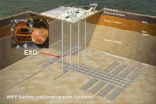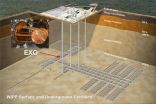(Press-News.org) Menlo Park, Calif. — Scientists studying neutrinos have found with the highest degree of sensitivity yet that these mysterious particles behave like other elementary particles at the quantum level. The results shed light on the mass and other properties of the neutrino and prove the effectiveness of a new instrument that will yield even greater discoveries in this area.
The Enriched Xenon Observatory 200 (EXO-200), an international collaboration led by Stanford University and the U.S. Department of Energy's (DOE) SLAC National Accelerator Laboratory, has begun one of the most sensitive searches ever for a mysterious mechanism called "neutrinoless double-beta decay" in which two neutrinos, acting as particle and antiparticle, do not emerge from the nucleus.
If this decay were observed, it would signal that neutrinos have a different quantum structure than other elementary particles. EXO-200, which is capable of detecting decays that happen, on average, only once every 10^25 years (1 quadrillion times the age of the universe), did not observe this decay, which constitutes the strongest evidence yet that neutrinos behave like other particles.
"The result could only have been more exciting if we'd been hit by a stroke of luck and detected neutrinoless double-beta decay," said Giorgio Gratta, a professor of physics at Stanford University and spokesperson for EXO-200. "In the region where double-beta decay was expected, the detector recorded only one event. That means the background activity is very low and the detector is very sensitive. It's great news to say that we see nothing!"
EXO-200 has been able to all but rule out a previous, highly controversial result claiming to have detected the decay, and they've also been able to narrow down the mass of the neutrino to less than 140- to 380- thousandths of an electronvolt (the unit of mass used in particle physics). For comparison, the minuscule electron has a mass of roughly 500,000 electronvolts.
At the heart of EXO-200 is a thin-walled cylinder made of extremely pure copper. It is full of about 200 kilograms (about 440 pounds) of liquid xenon and buried 2,150 feet deep at the DOE's Waste Isolation Pilot Plant (WIPP), a New Mexico salt bed where low-level radioactive waste is stored. The xenon—in particular the isotope xenon-136, which makes up the lion's share of the xenon in EXO-200—is one of the few substances that can theoretically undergo the decay. Constructing the experiment of exceedingly pure materials and locating it underground ensured that all other traces of radioactivity and cosmic radiation are eliminated or kept at a minimum.
EXO-200 will take data for a few more years and in the future, the team hopes to expand the technique to a several-ton version that would be even more sensitive at observing the nearly imperceptible physical processes that have been theorized.
EXO is a collaboration that involves scientists from SLAC, Stanford, the University of Alabama, Universität Bern, Caltech, Carleton University, Colorado State University, University of Illinois Urbana-Champaign, Indiana University, UC Irvine, ITEP (Moscow), Laurentian University, the University of Maryland, the University of Massachusetts – Amherst, the University of Seoul and the Technische Universität München. This research was supported by DOE and NSF in the United States, NSERC in Canada, SNF in Switzerland and RFBR in Russia. This research used resources of the National Energy Research Scientific Computing Center (NERSC).
INFORMATION:
SLAC is a multi-program laboratory exploring frontier questions in photon science, astrophysics, particle physics and accelerator research. Located in Menlo Park, California, SLAC is operated by Stanford University for the U.S. Department of Energy Office of Science. To learn more, please visit www.slac.stanford.edu.
DOE's Office of Science is the single largest supporter of basic research in the physical sciences in the United States, and is working to address some of the most pressing challenges of our time. For more information, please visit science.energy.gov.
Underground search for neutrino properties unveils first results
2012-06-05
ELSE PRESS RELEASES FROM THIS DATE:
Vaccinations of US children declined after publication of now-refuted autism risk
2012-06-05
New University of Cincinnati research has found that fewer parents in the United States vaccinated their children in the wake of concerns about a purported link (now widely discredited) between the MMR (measles, mumps, rubella) vaccine and autism.
Lenisa Chang, assistant professor of economics in UC's Carl H. Lindner College of Business, found that the MMR-autism controversy, which played out prominently in the popular media following publication in a 1998 medical journal, led to a decline of about two percentage points in terms of parents obtaining the MMR vaccine for ...
Physicists close in on a rare particle-decay process
2012-06-05
PASADENA, Calif.—In the biggest result of its kind in more than ten years, physicists have made the most sensitive measurements yet in a decades-long hunt for a hypothetical and rare process involving the radioactive decay of atomic nuclei.
If discovered, the researchers say, this process could have profound implications for how scientists understand the fundamental laws of physics and help solve some of the universe's biggest mysteries—including why there is more matter than antimatter and, therefore, why regular matter like planets, stars, and humans exists at all. ...
Emergency department algorithm may predict risk of death for heart failure patients
2012-06-05
Physicians can reduce the number of heart failure deaths and unnecessary hospital admissions by using a new computer-based algorithm developed at the Institute for Clinical Evaluative Sciences (ICES) that calculates each patient's individual risk of death. Published in the Annals of Internal Medicine, the algorithm improves upon clinical decision-making and determines whether or not a patient with heart failure should be admitted to hospital. To bring this tool into the emergency departments, Peter Munk Cardiac Centre cardiologists are developing smartphone and web-based ...
June 2012 story tips from Oak Ridge National Laboratory
2012-06-05
MATERIALS – Transparent performance . . .
Windshields, windows, solar panels, eyeglasses, heart stents and hundreds of other products representing a multi-billion-dollar market are potential targets for Oak Ridge National Laboratory's thin-film superhydrophobic technology. Conventional commercially available products tend to lack transparency, suitable bonding capability or both, making them largely impractical, said Tolga Aytug, one of the developers. The ORNL product, based on glass, can be produced with manufacturing processes that are cost effective and easily scaled ...
Depression treatment can prevent adolescent drug abuse
2012-06-05
DURHAM, N.C. -- Treating adolescents for major depression can also reduce their chances of abusing drugs later on, a secondary benefit found in a five-year study of nearly 200 youths at 11 sites across the United States.
Only 10 percent of 192 adolescents whose depression receded after 12 weeks of treatment later abused drugs, compared to 25 percent of those for whom treatment did not work, according to research led by John Curry, a professor of psychology and neuroscience at Duke University.
"It turned out that whatever they responded to -- cognitive behavioral therapy, ...
Life expectancy prolonged for esophageal cancer patients
2012-06-05
Reston, Va. (June 4, 2012) – For those with esophageal cancer, initial staging of the disease is of particular importance as it determines whether to opt for a curative treatment or palliative treatment. Research presented in the June issue of The Journal of Nuclear Medicine shows that physicians using positron emission tomography (PET)/computed tomography (CT) can discern incremental staging information about the cancer, which can significantly impact management plans.
In 2012, an estimated 17,500 people will be diagnosed with esophageal cancer and 15,000 will die from ...
New research yields insights into Parkinson's disease
2012-06-05
Researchers at the University of Toronto Scarborough (UTSC) used an innovative technique to examine chemical interactions that are implicated in Parkinson's Disease.
The work details how a protein called alpha-synuclein interacting with the brain chemical dopamine can lead to protein misfolding and neuronal death.
Parkinson's Disease is a neurodegenerative disease which results in loss of motor control and cognitive function. Although the cause isn't known precisely, the disease involves the death of brain cells that produce dopamine, a chemical important in neuronal ...
Mature liver cells may be better than stem cells for liver cell transplantation therapy
2012-06-05
Tampa, Fla. (June 4, 2012) – After carrying out a study comparing the repopulation efficiency of immature hepatic stem/progenitor cells and mature hepatocytes transplanted into liver-injured rats, a research team from Sapporo, Japan concluded that mature hepatocytes offered better repopulation efficiency than stem/progenitor cells.
Until day 14 post-transplantation, the growth of the stem/progenitor cells was faster than the mature hepatocytes, but after two weeks most of the stem/progenitor cells had died. However, the mature hepatocytes continued to survive and proliferate ...
Cell transplantation of lung stem cells has beneficial impact for emphysema
2012-06-05
Tampa, Fla. (June 4, 2012) – When autologous (self-donated) lung-derived mensenchymal stem cells (LMSCs) were transplanted endoscopically into 13 adult female sheep modeled with emphysema, post-transplant evaluation showed evidence of tissue regeneration with increased blood perfusion and extra cellular matrix content. Researchers concluded that their approach could represent a practical alternative to conventional stem cell-based therapy for treating emphysema.
The study is published in Cell Transplantation (21:1), now freely available on-line at http://www.ingentaconnect.com/content/cog/ct/.
...
Mosquitoes fly in rain thanks to low mass
2012-06-05
The mosquito is possibly summer's biggest nuisance. Sprays, pesticides, citronella candles, bug zappers — nothing seems to totally deter the blood-sucking insect. And neither can rain apparently.
Even though a single raindrop can weigh 50 times more than a mosquito, the insect is still able to fly through a downpour.
Georgia Tech researchers used high-speed videography to determine how this is possible. They found the mosquito's strong exoskeleton and low mass render it impervious to falling raindrops.
The research team, led by Assistant Professor of Mechanical Engineering ...


